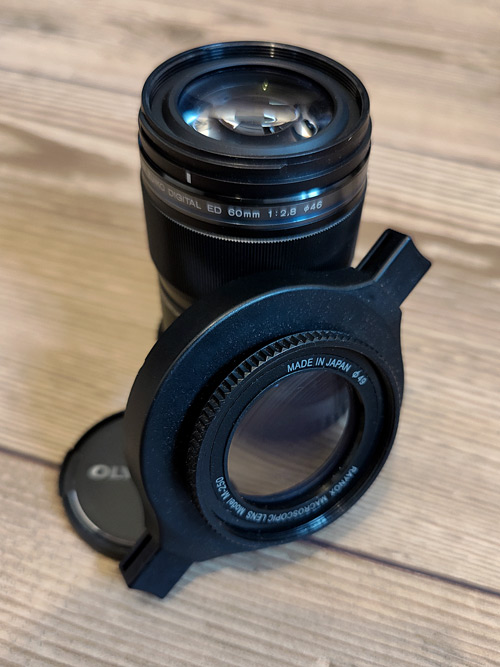31 Oct Caution: Raynox DCR250 damaging M.Zuiko 60mm lens

The problem and scenario
The combination of the OM SYSTEM / Olympus M.Zuiko Digital ED 60mm 1:2.8 macro lens with the Raynox DCR250 diopter clip-on lens is very popular among MFT macro photographers, as it offers a versatile setup to get the 60mm above 1:1 magnification.
However, there is a specific problem with this setup, as soon as direct sunlight gets added to the mix, which can damage your lens.
Update: from feedback to this article we know, that this is indeed a physical problem rather than a lens-specific one.
A fellow photographer had her Sony 90mm macro lens damaged in the same way.
In short: this can happen with any lens that is contructed in a specific way, most probably with relatively short barrel lenses.
It seems, that when direct sun rays enter the lens front element through the Raynox, it is the same as if you would try to light a fire with a magnifying glass.
The sun rays are getting bundled and focused, hitting the aperture blades with maximum energy and burning holes through them.
When you use a certain combination of step-up or step-down filter to fit your Raynox on, this might intensfy the situation, as it changes the layer where the hottest point of the focused light hits inside the lens.


Some reports indicate, that you would need direct, bright sunlight to hit the lens to cause that effect, while others deny having ever aimed the lens/camera directly at the sun, which indicates, that also intense stray light might cause problems.
Update 2: Another photographer has messaged me after reading the article and reported, that she had her lens damaged while photographing specimens on the ground, without ever aiming the lens towards the sun/sky at all.
Have a look at the photos from fellow macro photographers, that had their lenses irreparably damaged.
The damage patterns all look very similar.
Damage patterns and example photos






Be careful and protect your lens
As it will be very difficult to prove to the repair-service that you did not handle your lens in an inappropriate way, better be safe than sorry and only use this combination with extreme caution!
Always put a lens cap on the Raynox, when you are not photographing.
Never place your camera down on the ground with the lens facing towards the sky while the raynox is attached.
Personally i never had problems with the Raynox DCR250, but i do not use it as often as others, and rarely shoot into the sky, so i guess the damages might also be connected to specific styles of shooting.




Sign up for the newsletter mailing list & free ebook

Did you enjoy these tips and want to learn more or improve your macro photography skills?
Stay up to date with new blog posts, reviews and tutorial- and ebook-releases.
Sign up below to get notified when the free edition of my ebook
‘How to master spider & insect macro photography’ is ready for download.



Richard Gruszewic
Posted at 14:58h, 01 NovemberThanks so much for sharing this info. It happened to me as well and i had difficulties finding out more about what happened to my lens. I love my Olympus Equipment but the 60mm ist still too expensive to lose it that way. Let us hope this can prevent others to experience the same. Thanks again!
wildmacro-chris
Posted at 15:24h, 01 NovemberHi and thank you – that´s what i intended with the article, giving people some info when they look the issue up in the internet. The setup stil works, it is just that it´s important to handle it with care. I never had problems with it so far, still i have never heard of something similar happen with any other lens with the Raynox attached. It feels like the needle in a haystack.
Stefanie Mückner
Posted at 06:00h, 02 November„[…] still i have never heard of something similar happen with any other lens with the Raynox attached. […]“
Unglücklicherweise darf ich Dein Wissen dahingehend erweitern. Ich habe mir letzten Sommer auf diese Weise leider mein SONY 90mm Macro zerschossen. Es ist ein grundsätzlich physikalisches Problem, kein olympusspezifisches.
wildmacro-chris
Posted at 09:57h, 02 NovemberHallo Stefanie, danke dir für das – wichtige – Feedback. Es macht auch Sinn, dass das Problem bei Linsen, wo der gebündelte Punkt entspr. ähnlich innenliegend auf “etwas” trifft, ebenfalls auftritt. Es war mir bisher lediglich nicht bekannt von anderen Kombinationen. Ich ergänze den Artikel um deinen Kommentar, danke!
Mark
Posted at 22:22h, 03 NovemberWould this be Raynox specific or, as I suspect, would Nisi also be affected?
Dan M
Posted at 08:29h, 12 NovemberThis is exactly what must have happened to my Oly 60 as well! The fact that it is offset to one side of the aperture probably means that any off-axis direct sunlight could potentially be focused through onto the blades. Be careful out there